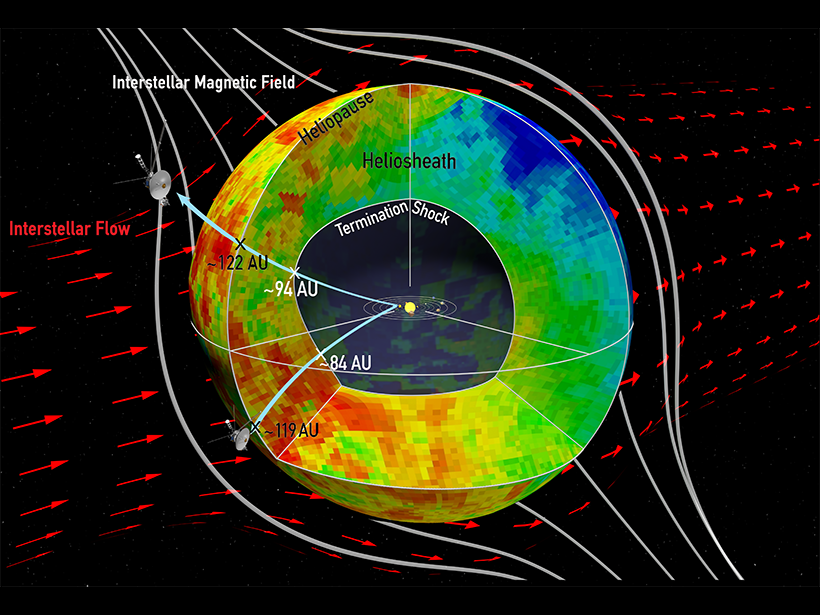Source: Geophysical Research Letters
Charged particles that spew into space as part of the solar wind create a protective magnetic bubble tens of billions of kilometers wide around the solar system. This bubble, called the heliosphere, plows through the harsh cosmic radiation of interstellar space.
Understanding the physics at the bubble’s edge, called the heliosheath, is not easy. The boundary is in constant flux and pushes out against the broader interstellar magnetic field that permeates our corner of the Milky Way. Only two spacecraft—Voyager 1 and 2, originally launched by NASA in 1977—have ever traversed the frontiers of our local bubble.
Now Dialynas et al. have combined Voyager data with observations from NASA’s Cassini mission, which orbited Saturn from 2004 to 2017, to gain more insight into this region of space. The researchers recognized that the missions, although launched 20 years apart, had collected complementary data. Voyager 1 and 2 had instruments that measured energetic ions as the craft crossed the heliosheath and exited the solar system. Cassini, meanwhile, was able to remotely observe energetic neutral atoms (ENAs) arriving in all directions from the heliosheath.
These two phenomena are related: ENAs come from the heliosheath, where fast solar wind protons collide with neutral hydrogen atoms from interstellar space and “steal” an electron from the interlopers. The Voyager probes took in situ measurements of the parent heliosheath proton distributions as they passed through this region. Meanwhile, the protons with newly added electrons become ENAs and zip off in all directions.
The synergy among the spacecrafts’ observations allowed the researchers to use Voyager data from the heliosheath to ground truth and calibrate ENA data from Cassini, which was more sensitive to lower energetic particles than Voyager was. Together, the spacecraft extended data on the intensity of both ENAs and ions to include a broader range of energies, which gave the team a window into the physics in the heliosheath as the solar wind and interstellar medium press against each other.
The researchers found that in the energy range considered in their study (>5 kiloelectron volts), lower-energy ions with energies between about 5 and 24 kiloelectron volts played the largest role in maintaining the pressure balance inside the heliosheath. This allowed the team to calculate the strength of the magnetic field and the density of neutral hydrogen atoms in interstellar space—about 0.5 nanotesla and 0.12 per cubic centimeter, respectively.
On the basis of calculations from Voyager 2 data, the researchers predict that the heliopause, the outer boundary of the heliosheath, is located roughly 18 billion kilometers from the Sun, or 119 times the distance from the Sun to the Earth—right where Voyager 2 found it in November 2018.
Furthermore, the finding that the lower-energy ions dominate the pressure balance in the heliosheath means that space physicists will have to rethink their assumptions about the energy distribution of such particles in the heliosheath. (Geophysical Research Letters, https://doi.org/10.1029/2019GL083924, 2019)
—Mark Zastrow, Freelance Writer
Citation:
Zastrow, M. (2019), Sampling the space between the stars, Eos, 100, https://doi.org/10.1029/2019EO131205. Published on 19 August 2019.
Text © 2019. The authors. CC BY-NC-ND 3.0
Except where otherwise noted, images are subject to copyright. Any reuse without express permission from the copyright owner is prohibited.

